UNHCR recently released a ‘Global Trends – Forced Displacement in 2021’ report that provides insights into the magnitude of this global problem along with the spatial & temporal trends. As per this report, by the end of 2021, the number of people forcibly displaced is around 89.3 million, more than twice the 42.7 million by the end of 2012.
The ongoing Russia-Ukraine war has created a Humanitarian crisis, with the latest estimates indicating that there could be around 5.2 million refugees from Ukraine across Europe. It is estimated that around 8 million have crossed the border from Ukraine since the escalation of the conflict in late February 2022. The destruction of civilian spaces and the proximity to the conflict zones have forced people to abandon their homes and seek safety.
This crisis adds to the millions of other forcibly displaced individuals across the world. Persecution, conflict, violence, human rights violations and other events in various places across the world have contributed to this forced displacement. Recently, the United Nations High Commissioner for Refugees (UNHCR) released a ‘Global Trends – Forced Displacement in 2021’ report that provides insights into the magnitude of this global problem along with the spatial & temporal trends of forced displacement of people. UNHCR, the UN Refugee Agency is a global organization dedicated to saving lives, protecting rights, and building a better future for refugees, forcibly displaced communities, and stateless people.
The number of forcibly displaced people has more than doubled in ten years
As per UNHCR, by the end of 2021, the number of people forcibly displaced is around 89.3 million. Around 6.9 million additional people were added in 2021. Out of the 89.3 million, 27.1 million are refugees, 53.2 million are Internally Displaced People (IDP), 4.6 million are asylum seekers and another 4.4 million are Venezuelans who are displaced abroad.
The trends over the last 10 years indicate and a year-on-year increase in the number of people displaced globally, with a higher increase observed in recent years. Nearly 20 million were displaced in the last four years (2017-2021). In fact, over the last 10 years (2012-2021), the number of displaced people has more than doubled. By the end of 2012, there were 42.7 million displaced people globally.
There is a higher growth of IDP. In 2012, there were 17.7 million IDPs and 10.5 million refugees. While the internal displacements continue to be higher, the number of people crossing borders to seek refuge is fewer compared to pre-pandemic levels, primarily due to COVID-19-related restrictions of movement.
Those forcibly displaced constitute 1 out of 88 in the world population by end of 2021, while in 2012, it was 1 in 167. This implies that the growth of the displaced population has outpaced the growth of the world population, highlighting the severity of the problem.
41% of those forcibly displaced are children under the age of 17 years, higher than the share of children in the world population (31%), indicating the higher vulnerability of children. 53% of the displaced belong to the age group of 18-59. There isn’t much variance between the male & female populations being displaced with a 51:49 ratio of males & females among the displaced population by end of 2021.
The war in Ukraine has already added around 7 million displaced people and as per estimates, the total number of people displaced globally would cross 100 million by the end of 2022.
UNHCR identifies 94.7 million people as a population of concern
As indicated above, the total number of forcibly displaced people includes refugees, asylum-seekers, internally displaced people, and Venezuelans displaced abroad. It also includes refugees and other displaced people who are not covered by UNHCR’s mandate. However, the forcibly displaced numbers do not include other categories like returnees, non-displaced state-less people, etc. But these categories are of concern to UNHCR, and it is mandated to protect and assist them.
The categories of people that are considered as Population of Concern to UNHCR, and whom UNHCR is mandated to protect include – people who are forcibly displaced, those who returned home within the previous year, those who are stateless, and other groups of concern to whom UNHCR has extended its protection or provided assistance on a humanitarian basis. By end of 2021, the total population of concern for UNHCR was 94.7 million. In 2020, there were 91.9 million people of concern for UNHCR.
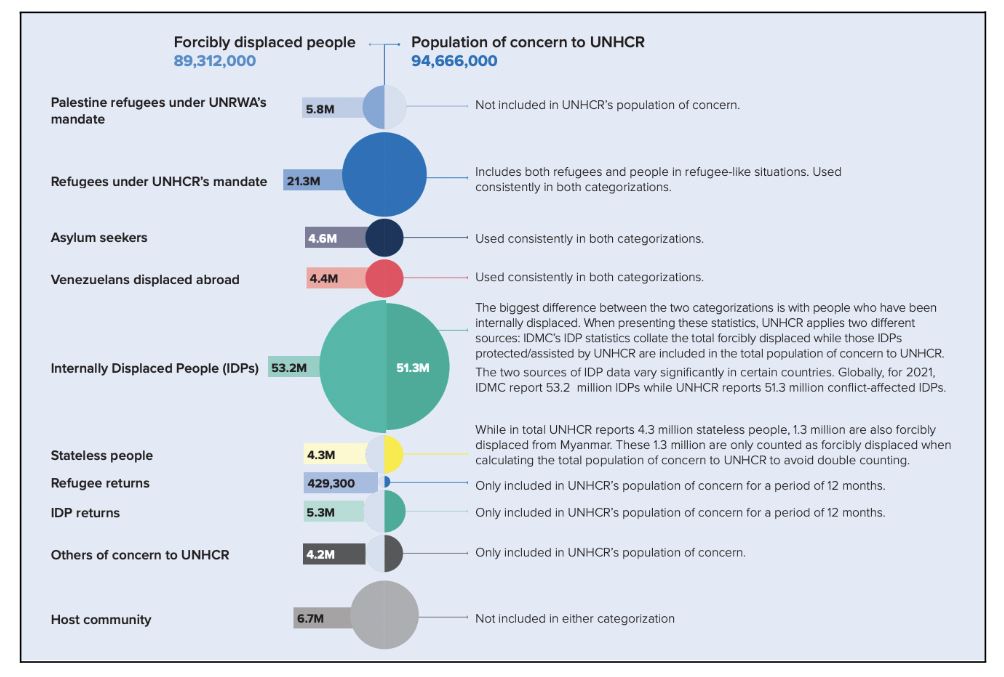
23 countries faced high or medium-intensity conflicts in 2021
The report highlights during 2021, several existing conflicts have escalated, and new conflicts flared up. Around 23 countries with a combined population of 850 million faced high or medium-intensity conflicts in 2021. The number of countries in conflict has doubled compared to 2012.
12 countries in Africa have seen displacements due to conflicts in 2021. These include – Somalia, Ethiopia, Sudan, South Sudan, Mozambique, Nigeria, Niger, Central African Republic (CAR), Democratic Republic of the Congo (DRC), Chad, Mali & Burkina Faso. Among these countries, DRC has around 3 million people who were internally displaced. About half a million in CAR and another half-million in Sudan were newly displaced in 2021.
Extreme poverty & under-development have contributed to the increasing displacements in Burkina Faso & Mali.
The continued instability in Syria has resulted in more new displacements. Other Asian countries which have witnessed new displacements were Yemen, Afghanistan & Myanmar. In Latin America, more Venezuelans were displaced abroad once the COVID-19 restrictions were lifted. Meanwhile, the pollical crisis in Nicaragua has resulted in more than 100 thousand new asylum applications.
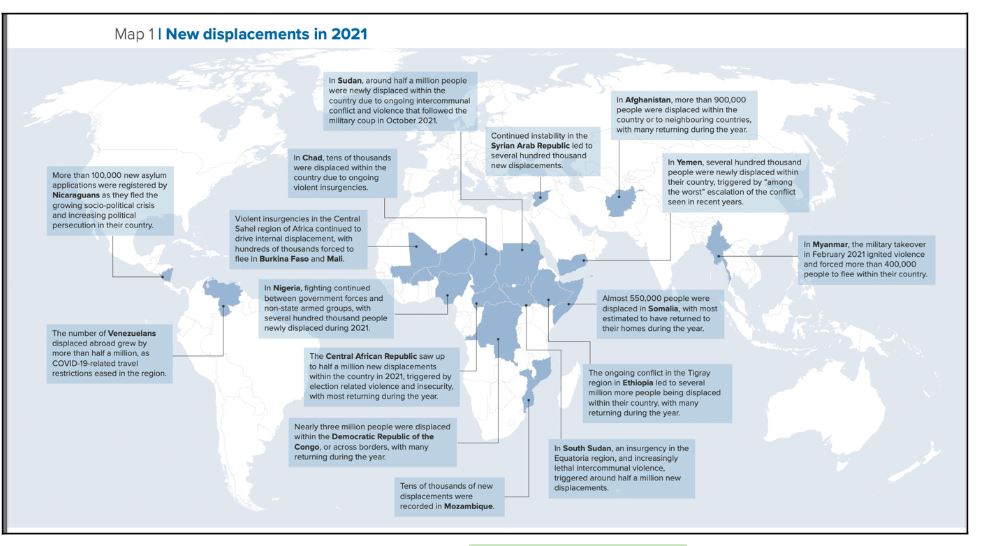
The ongoing crisis in Ukraine is not only the largest since World War II but is also the fastest. The only relief about displacements from Ukraine is that these refugees are being settled in higher-income European countries. The situation is dire for displacements in other countries, with many of the people that are forced to flee being impacted by food crises. Around 82% of Internally displaced people and 67% of refugees are from countries with food crises. For instance, in Afghanistan, 55% of the population did not have enough to eat each day. Nearly 40% of the refugees and asylum seekers are hosted in countries with food crises.
Syria is the country of origin for the highest number of people displaced across the borders
In 2012, the number of refugees worldwide was 10.5 million. During the 10-year period (2012-21), the number more than doubled to 21.3 million by the end of 2021. During this period, the number of Venezuelan refugees increased from 3.9 million to 4.4 million. Around 794 thousand people were provided with international protection in 2021.
83% of the people fleeing their country of origin are from 10 countries. People fleeing Syria and being hosted in other countries are the highest with 6.8 million i.e., 27% of the global refugee population. In 2021, the number of Syrian refugees increased by 145 thousand, aided by new births and a rise in recognition in the host countries. Syrian refugees are being hosted in 129 countries. Germany & Austria are among the leading nations that have provided recognition for the refugees from Syria. However, the highest number of Syrian refugees are still hosted in the neighbouring countries of Turkiye (erstwhile Turkey), Lebanon & Jordan, while Germany is the largest non-neighbouring host country.
Venezuela is the second-largest country of origin for refugees with 4.6 million. Most of them are hosted and recognized in other countries in the Americas. Around 2.7 million Afghan refugees are being hosted in 98 countries. The African countries of South Sudan, DP Congo, Somalia, Sudan, Central African Republic, and Eretria are among the top 10 countries of origin and contribute to a combined 6.18 million refugees from these countries. Rohingyas are among the highest displaced community with the numbers increasing to 1.2 million, and most of them being hosted in Bangladesh.
Turkiye is the host of the highest number of refugees with 3.75 million refugees, with almost all of them being Syrians. 72% of the global refugee population is hosted by neighbouring countries. 27% of the refugees are hosted by least-developed countries while 83% of the population is hosted by low- & middle-income countries, causing more stress to the host countries.
3/4th of the new Internal displacements in 2021 were in Sub-Saharan Africa
People displaced inside their own countries constitute most of the global forcibly displaced population. Armed conflicts, generalized violence, human rights violations, etc., are among the major contributing factors to internal displacements. By the end of 2021, UNHCR reported situations of Internal displacements in 35 countries. The number of Internally Displaced People (IDPs) increased from 17.7 million in 2012 to 51.3 million in 2021.
Nearly 3/4th of the new internal displacements in 2021 are reported from Sub-Saharan African countries, especially with the countries in East and Horn of Africa and the great lakes region. 4.1 million IDPs were reported from Ethiopia, Somalia, South Sudan & Sudan. In West & Central Africa, around 1.6 million new displacements were reported in 2021. Chronic under-development, economic inequality, and other socio-economic factors are the key drivers of internal displacement in West & Central African countries.
Among the IDPs recognized and protected by UNHCR, Syria has the highest number of Internal Displacements with 6.9 million people. It accounts for 1/3rd of the population residing in Syria. 6.8 million people in Columbia are recognized as internally displaced.
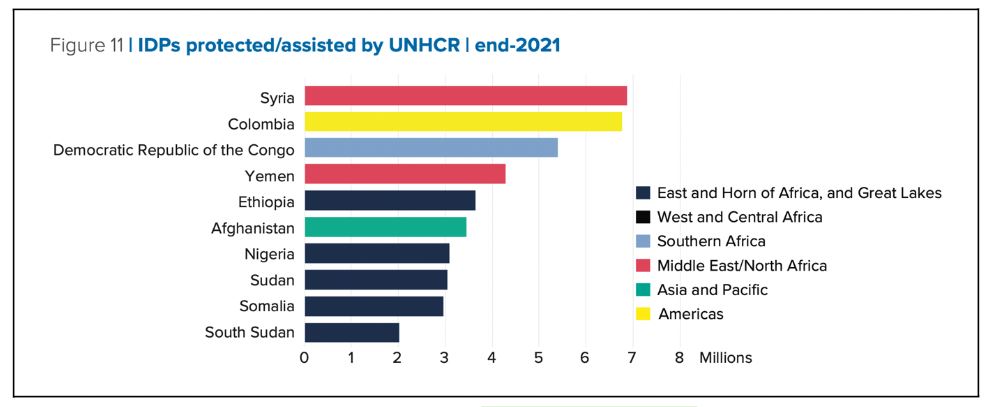
This data recorded by UNHCR only includes displacement due to conflict and violence. As per Internal Displacement Monitoring Centre, there are another 23.7 million internal displacements due to disasters & climate change. Among those displaced due to disasters in 2021, the highest was in China with 6 million. Philippines & India have the next highest internally displaced populations due to disasters in 2021 with 5.7 million and 4.9 million respectively.
4.3 million State-less people by the end of 2021
Apart from the refugees, IPDs and asylum seekers, there are around 4.3 million people who are stateless or of undetermined nationality. They are not recognized by any of the countries and hence are unable to access basic rights. Their number has increased by 158 thousand in 2021 compared to 2020. States recognizing the existence of State-less people and gathering information about them is one of the major challenges, post which efforts can be made to find solutions for their resettlement.
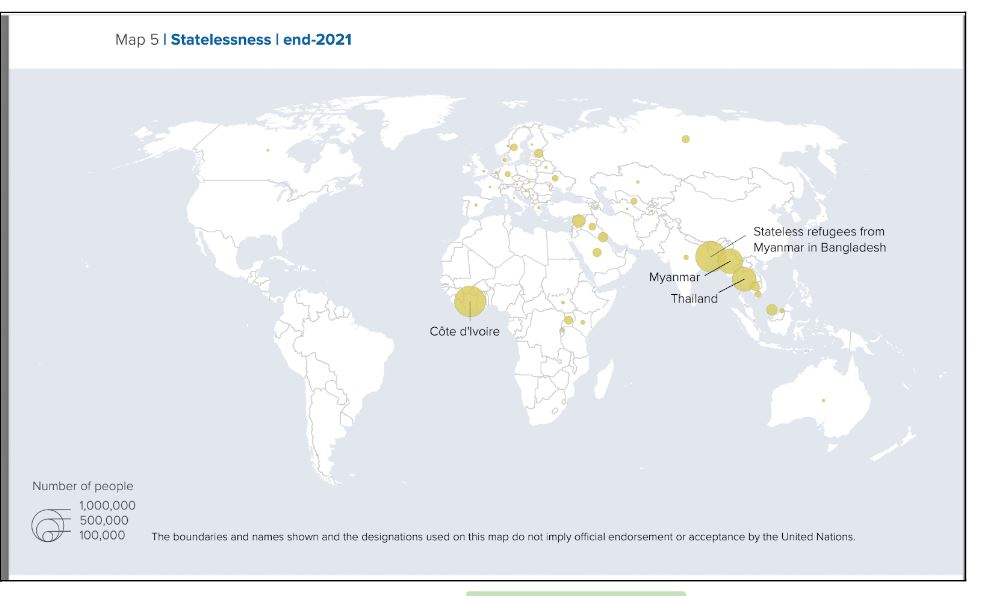
5.7 million displaced people have returned to their place of origin in 2021
While there were new situations in 2021 that have contributed to an increase in the forcibly displaced population worldwide, the existing situations continue to remain unsolved and in need of durable solutions. Enabling refugees to rebuild their lives and lead a life of safety & dignity by providing durable solutions remains a priority for UNHCR.
Voluntary repatriation, local integration, and resettlement to a third country are among the durable solutions for the refugees. Returning to the home country is the preferred solution for most of the refugees, but that is dependent on the political stability and economic opportunities in their countries of origin.
429.3 thousand refugees returned to their countries of origin in 2021, with the returns in that year compared to pre-pandemic years. 2/3rd of the refugees who returned was to South Sudan. 36.5 thousand Syrian refugees returned to their home country in 2021.
Resettlement is another option exercised by the UNHCR to protect the most vulnerable refugees. 86% of those resettled are victims of torture and abuse, with most of them being women & children. Despite an increase in 2021, the number of people resettled remains lower compared to pre-pandemic years. The share of those resettled among those who need resettlement is traditionally lower.
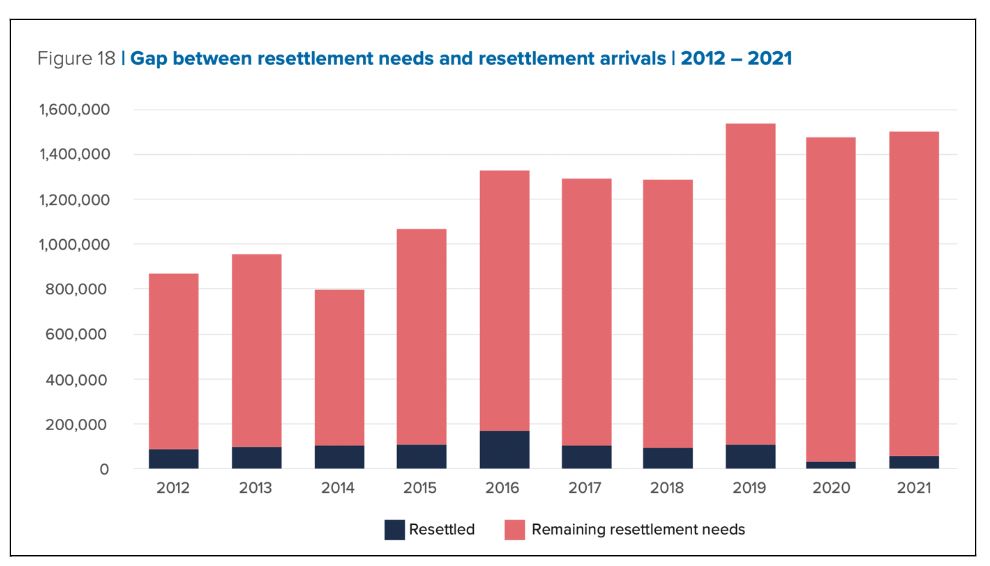
Overall, 5.7 million displaced people returned to their place of origin, of which 5.3 million were IDPs. Around 57.5 thousand refugees were resettled in 2021.
Featured Image: UNHCR’s Global Trends Forced Displacement in 2021 report


